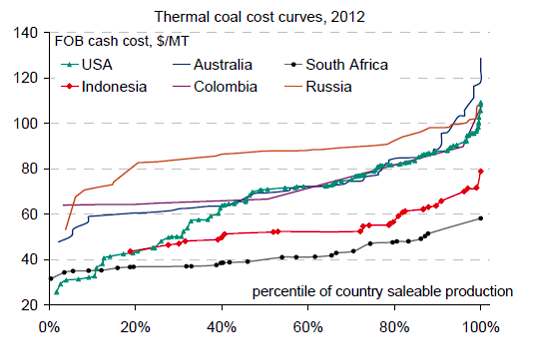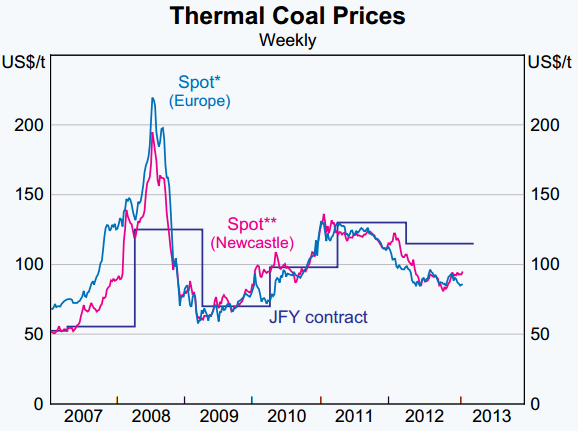THOUSANDS more jobs could be cut from the NSW coal industry by year-end as miners struggle to turn a profit on reduced prices and higher costs, an issue they argue is being compounded by rising uncertainty in the government approvals process.
The major coalminers in the state, including Rio Tinto and Xstrata, have already cut hundreds of employees from operations and global giant Rio warned this week that hundreds more could go following a court decision to block an expansion at one of its NSW operations.
With more than 36 per cent of Australian thermal coalmines operating at a loss and about 45 per cent of the country’s coking coal industry making a loss, the sector argues government processes will drive investment offshore.
Let’s take a moment to check out the recent history of prices for thermal coal:
This chart is a month or two too old. The JFY is now below its 2010 price and is obviously under consistent pressure. The claim that ‘36% of thermal coal mines are running at a loss’ appears to come from the Minerals Council. It is higher than I would have estimated but the following chart from BAML suggests it is not that exaggerated:

That is not to say that there is no problem. As you can see, a large slab of producers are marginal in the mid $85 range.
The article goes on:
Rio Tinto held “crisis talks” with the O’Farrell government this week as the industry chorus against the state’s approvals process for mining projects became louder.
…With no shortage of other countries willing to supply the growing demand that will continue from China and India, the industry argues that if the policy settings in Australia, and in particular NSW, are not supportive of the sector, future opportunities will be lost.
“They should be helping us to lower our costs if they want the investment. There is an aspect of disbelief that the industry is still the milking cow when at least a third of the thermal industry is loss-making,” one miner said.
The main cause of the margin squeeze is falling prices. The reasons for this are well known. The Chinese have shifted towards lower carbon output fuels for electricity output growth, cheap US gas has freed up coal for export, subdued global growth is suppressing power demand and cheap coal is coming on stream everywhere as capex delivers. In short, miners have over-invested.
The thermal coal debate is therefore not about how to attract new investment and build more mines. It’s about how to retain the mines we have as the shakeout worsens. Focusing on slow approvals processes for new mines in therefore either loopy or deliberately misleading in this context and bodes poorly for coal jobs.


